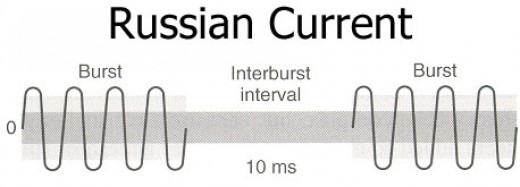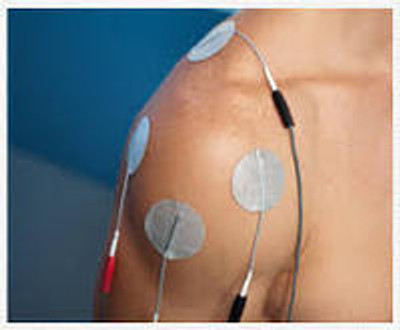 23rd May 2016
23rd May 2016
Waveforms Used In Electrical Stimulation Therapy
Electrical Stimulation Therapy and It's Applications
Electrical stimulation therapy (E-stim) is a popular therapeutic modality used by physical therapists, chiropractors, occupational therapists, and other physicians. E-stim therapy is commonly used to help treat pain, but is also useful has the ability to:
- improve circulation
- improve muscle control
- increase muscle strength and tone
- target other specific conditions (e.g. treating excessive sweating in a person’s hands)
How Does Electrical Stimulation Work?
Electrodes are attached to patient’s skin and when used, e-stim causes specific muscles to contract. This contraction is an important function for a few reasons: it allows muscles to maintain strength and muscle tone that may atrophy from disuse and it since it mimics the way the body moves during exercise it can help increase a patient’s range of motion.
There are different waveforms used in electrical stimulation therapy and these waveforms perform differently and have varied rehabilitative attributes.
Different Waveforms Used in Stimulation Therapy
The various waveforms used in e-stim are designed to target specific areas of the body and to provide customized forms of energy transfer. This variance in energy transfer helps address diverse therapy needs.
Russian Current
The Russian Current waveform is a type of electrical stimulation that delivers medium frequency current in alternating pulses or bursts of energy. This type of stimulation generates a motor response which can be used to strengthen muscles and muscular re-education. A study published in the International Journal of Rehabilitation and Science found that Russian current used in addition to physical therapy increased quadriceps strength in burn patients more than patients that received physical therapy alone. To add to its versatility, Russian Current can also be used to stimulate an analgesic effect in the muscles, making it effective in reducing pain as well as increasing muscular strength.

Russian Current Waveform
Interferential Current (IFC)
Interferential Current (also referred to as IFC) is used to address chronic, post-surgical and post-trauma acute pain in patients. The benefits of using IFC e-stim therapy when treating patient pain is that it’s non-invasive, has minimal side-effects and provides a safe non-pharmacological choice for treatment. IFC works at a higher frequency meaning the energy crosses the skin with easier and with less stimulation. Because of its ease in reaching deep into pain sites and the increased tolerance for patients, IFC is a popular waveform for rehabilitation. Additionally, the IFC waveform offers deep tissue penetration over a larger volume of tissue, making it a great choice when treating conditions like: back pain, arthritis, shingles, etc.
Interferential Current Used in Electrotherapy
Premodulated Current (Premod)
Premodulated Current, also referred to as “premod”, is similar in its benefits and ease of use for patients as interferential current. The main difference between the two is how the current is delivered to the patient’s muscle tissue. With premod current, a single channel is used to mix the frequencies prior to delivery of the current through the electrode of the body (using two electrodes rather than four). This is beneficial when treating areas of the body that have less space available for electrode placement. This makes it the perfect choice to use on smaller muscle groups and joints such as the elbow, ankle, foot, and hands. For example, premodulated current would be effective in treating pain associated with tennis elbow.
Biphasic Current
"Biphasic" refers to two phases, or pulses, of 2 different intensities alternating with each other during treatment. Biphasic current is considered the most versatile of the stimulation therapy waveforms because most devices feature settings that allow control of amplitude (intensity), stimulation (voltage), current, and duration of each pulse. With its versatility and effectiveness, Biphasic current e-stim can be used to:
- strengthen muscles
- re-educate muscles
- increase circulation
- decrease swelling
Biphasic treatment is used to treat both acute and chronic pain, muscular and disc syndromes in the back and neck, arthritis, shoulder syndromes, neuropathies, etc.
High Voltage
The theory behind the use of high voltage current centers on the belief that its current is able to achieve deeper tissue penetration. High voltage current was developed as a monophasic waveform that would reach deeper into the body tissue. High Voltage electrical stimulation uses polarity (positive or negative) to stimulate the tissue. This type of stimulation can be used to decrease pain, edema or facilitate in wound healing. Because of its ability to aid in circulation, High Voltage can be used to great effect in healing wounds in patients with circulatory issues such as diabetes. Additionally, this waveform can be used to relieve muscle spasms.
Microcurrent
Microcurrent utilizes micro-size, pulsating current to resonate with the body’s own bio-electrical exchanges that take place at the cellular level.When microcurrent is applied, it triggers impulses to facilitate a chemical reaction to activate the release of adenosine triphosphate (ATP) at the cellular level, which is used to facilitate wound or tissue healing. Microcurrent is considered sub-sensory, implying that the intensity does not cause any visual jolting muscular movement, so it’s more comfortable for patients.
Related Article : Therapeutic Modality Guide - Popular Physical Therapy Tools
Clinical Use of Electrotherapy Waveforms
Most electrotherapy equipment includes at least some combination of these waveforms. The American Physical Therapy Association acknowledges the use of Electrotherapy for:
1. Pain management
- Improves range of joint movement and motion
2. Treatment of neuromuscular dysfunction
- Improvement of strength
- Improvement of motor control
- Retards muscle atrophy
- Improves local blood flow
3. Improves range of joint mobility
- Induces repeated stretching of contracted, shortened soft tissues
4. Tissue repair
- Enhances microcirculation to heal wounds
- Restores integrity of connective tissues
5. Acute and chronic edema
- Accelerates absorption rate
- Affects blood vessel permeability
- Increases circulation of lymph
6. Peripheral blood flow
- Improves circulation
7. Iontophoresis
- Aids in delivery of pharmacological agents
8. Urine and fecal incontinence
- Affects pelvic floor musculature to reduce pelvic pain and strengthen musculature
- May lead to complete continence
With its versatility of treatment options and ability to treat across diverse patient populations, electrical stimulation devices are a popular modality used in rehabilitation for good reason.
Find more electrotherapy information at ProHealthcareProducts.com






